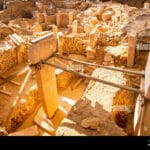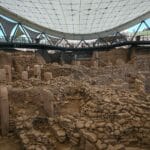Journey to the Dawn of Civilization
Imagine a place older than the pyramids, even older than farming or writing itself. This is Göbekli Tepe in Turkey, an archaeological marvel that has captivated the world and challenged our understanding of human history.
Want an up-close and personal look at the ancient wonders of Gobekli Tepe? Explore our Gobekli Tepe images for a visual journey through time. From majestic stone structures to intricate carvings, immerse yourself in the enigmatic world of one of the oldest known human settlements. Discover the secrets of Gobekli Tepe’s vast history through our Gobekli Tepe photos that capture the essence of this remarkable archaeological site.
Unveiling the Secrets of Göbekli Tepe: A Deep Dive into the World’s Oldest Temple
Get ready to journey back in time to a place where ancient secrets are revealed through captivating images. Göbekli Tepe in Turkey is an archaeological treasure trove, offering us glimpses into the lives and beliefs of our ancestors from a time long before recorded history.
Imagine massive stone pillars arranged in circles, towering over the landscape. These aren’t just any pillars; they’re covered in intricate carvings of animals and people, each one telling a story. These images, found at Göbekli Tepe, are like snapshots of life from over 12,000 years ago, a time archaeologists call the Neolithic period.
Masterful Craftsmanship and Symbolic Imagery
The craftsmanship of these carvings is awe-inspiring. The artists who created them were masters of their craft, using simple tools to carve detailed images into hard stone. These images weren’t just decorations; they were powerful symbols that held deep meaning for the people who created them.
Lions, snakes, birds – these animals appear again and again at Göbekli Tepe. Each creature likely held special significance. Lions, with their strength and power, might have represented protectors or rulers. Snakes, often associated with wisdom and transformation, could have symbolized knowledge or spiritual guidance. And birds, soaring through the sky, might have been seen as messengers between the earthly and spiritual realms.
Intentional Architecture and Human Depictions
The architecture of Göbekli Tepe is just as impressive as the carvings. The pillars weren’t placed randomly; they were carefully arranged in large circles, forming what archaeologists call enclosures. These enclosures were probably used for special gatherings and ceremonies. Imagine people coming together from miles around to celebrate, worship, and share stories within these sacred spaces.
The human figures depicted in the carvings are particularly interesting. Some are simple outlines, while others are more detailed, showing clothing, hairstyles, and even facial expressions. These figures offer tantalizing clues about the people of Göbekli Tepe. Were they shamans, communicating with the spirit world? Were they leaders, guiding their communities? Or were they simply members of this ancient society, going about their daily lives?
A Monumental Significance and Artistic Legacy
The discovery of Göbekli Tepe sent shockwaves through the archaeological world. Its existence challenged everything we thought we knew about early human civilization. It suggests that complex societies, capable of monumental architecture and sophisticated symbolism, existed much earlier than previously believed.
But Göbekli Tepe is more than just an archaeological site; it’s a reminder of the enduring power of human creativity and ingenuity. The people who built this place lived in a very different world than ours, yet they shared our capacity for wonder, our desire to make sense of the world around us, and our need to connect with something larger than ourselves.
A Portal to the Past
The images from Göbekli Tepe are more than just pretty pictures; they’re portals to a lost world, inviting us to explore the mysteries of our ancient past. Each carving, each structure, each stone whispers stories of a time long ago, stories waiting to be heard, understood, and passed down through generations to come.
As our understanding of Göbekli Tepe continues to evolve, one thing remains certain: these captivating images offer a profound glimpse into the depths of human history and the boundless potential of the human spirit.
What Makes Göbekli Tepe So Special?
Göbekli Tepe isn’t your typical archaeological site. It’s like stumbling upon a hidden room in an ancient house, a room filled with secrets that make you question everything you thought you knew. Located in southeastern Turkey, this place is a UNESCO World Heritage site, and with good reason. It’s completely upending our understanding of how civilization began, pushing back the timeline of human achievement in ways we never imagined.
What makes Göbekli Tepe so special? It’s unbelievably old. Picture this: it was built somewhere between 9500 and 8000 BCE. That’s thousands of years before humans were thought to have figured out things like pottery, farming, or even living in one place for a long time. It’s like finding a skyscraper in the middle of the Stone Age. This blows the whole timeline wide open! It suggests that humans were developing complex religions and building monumental structures long before we ever thought possible. Talk about a reality check!
The site itself is pretty awe-inspiring. Imagine giant stone pillars arranged in circles, some weighing up to 16 tons – that’s heavier than a school bus! These pillars aren’t just big, they’re covered in intricate carvings of animals, people, and mysterious symbols. It’s like trying to decipher a message from the dawn of time. These carvings give us a peek into the beliefs and rituals of the people who built Göbekli Tepe, a glimpse into a world that existed thousands of years ago.
So, what was Göbekli Tepe used for? Honestly, we’re still trying to figure that out. Some archaeologists think it was a ceremonial center, a place where people came from miles around to worship and perform rituals. Others believe it might have been an ancient observatory, its design aligned with the stars and planets. There’s even a theory that it was a meeting place for nomadic hunter-gatherers, a central hub for socializing and sharing knowledge.
The truth is, Göbekli Tepe is still a giant question mark. Every discovery seems to lead to more questions, more mysteries to unravel. And that’s what makes it so fascinating! It’s a reminder that we still have so much to learn about our past, about who we are and where we came from.
How Do We Know Göbekli Tepe is 12,000 Years Old?
We know that Göbekli Tepe wasn’t built last week because scientists have ways of figuring out how old things are. Imagine a detective dusting for fingerprints, but instead, they’re looking for clues in time! One of their most reliable tools is something called “radiocarbon dating,” which works especially well on things that used to be alive, like wood or bone. Here’s how it works: Everything living thing constantly absorbs a tiny amount of a special type of carbon called carbon-14 from the atmosphere. When something dies, it stops taking in this carbon-14. The interesting part is that carbon-14 naturally decays at a very predictable rate. So, by measuring how much of it is left in something ancient, scientists can figure out roughly when it died. It’s like looking for clues in the slow fading light of a dying star!
At Göbekli Tepe, archaeologists found charcoal – the leftover bits from ancient fires – near the stone structures. This charcoal, probably from the wood people burned all those millennia ago, was perfect for radiocarbon dating. By analyzing these samples, they discovered something amazing. The results suggested that the earliest structures at Göbekli Tepe were built sometime between 9500 and 9000 BCE. That puts Göbekli Tepe way back, making it one of the oldest known examples of human-made structures anywhere on Earth.
Think about it – 9500 BCE! That’s before the pyramids, before Stonehenge, even before pottery was widely used! Göbekli Tepe might entirely change how we view the timeline of human civilization. It suggests that people were capable of complex thought, sophisticated construction, and perhaps even organized religion far earlier than we previously believed. While radiocarbon dating offers us a glimpse into the past, there’s still much we don’t know. Göbekli Tepe continues to be a site of active research, and new discoveries might change our understanding of its age and significance.
Why is Göbekli Tepe Mysterious?
Göbekli Tepe isn’t your average archaeological dig. This place, tucked away in southeastern Turkey, has got archaeologists and historians scratching their heads for a bunch of reasons.
One of the biggest head-scratchers? Its age. This place was built around 9500-8000 BCE, which might not sound that crazy at first. But get this – that’s thousands of years before people even figured out pottery or farming. We used to think that humans couldn’t build anything this massive and complex without first settling down and developing agriculture. Göbekli Tepe throws that whole idea out the window.
Then there’s the question of what it was even for. Was it a temple? A gathering spot for special occasions? Some experts suggest it might have been a place for astronomical observations, but others believe its purpose was deeply rooted in rituals and symbolism we may never fully grasp. The incredible carvings found there just make things even more intriguing. We’re talking about detailed images of animals, people, and symbols etched into massive stone pillars, some weighing over 16 tons! These weren’t just doodles; they point to a society with a complex set of beliefs and a knack for artistic expression that we haven’t seen this early in history.
And get this – these early humans managed to build this whole thing using tools that would seem primitive by today’s standards. It makes you wonder, how did they organize themselves to pull this off? How did they move and shape those huge stones with such precision? We’re left with a sense of awe at their capabilities.
As if all that wasn’t mysterious enough, around 8000 BCE, someone decided to bury the entire site on purpose. Why go through all that trouble? Was it to protect it? Was it part of a ritual? It’s like they wanted to leave us with more questions than answers.
Here’s the thing about Göbekli Tepe – every discovery seems to lead to even more questions. It challenges our assumptions about the past and how civilizations developed. While research is ongoing and new discoveries are always possible, Göbekli Tepe is likely to remain a source of fascination and debate for a long, long time.
Key Points
- Göbekli Tepe: An archaeological site in Turkey offering insights into pre-history.
- Carved Stone Pillars: Covered in intricate animal and human carvings, depicting life in the Neolithic period.
- Masterful Craftsmanship: The carvings demonstrate advanced artistic skills, using simple tools.
- Symbolic Imagery: Animals (lions, snakes, birds) depicted in the carvings likely held significant cultural and spiritual meanings.
- Intentional Architecture: The pillars were carefully arranged in circular enclosures, possibly for special gatherings and ceremonies.
- Human Depictions: Carvings show human figures in various forms, hinting at social roles, beliefs, and daily life.
- Monumental Significance: The scale and complexity of Göbekli Tepe challenge previous assumptions about the capabilities of early human societies.
- Artistic Legacy: The people of Göbekli Tepe possessed remarkable creativity and ingenuity, expressed through their carvings and architecture.
- Portal to the Past: The images at Göbekli Tepe provide a glimpse into a lost world, inviting exploration and understanding of ancient mysteries.
- Ongoing Research: Ongoing studies continue to deepen our knowledge about Göbekli Tepe and its significance in human history.
- Unveiling Bernhard Caesar Einstein’s Scientific Achievements: A Legacy in Engineering - July 15, 2025
- Uncover who is Jerry McSorley: CEO, Family Man, Business Success Story - July 15, 2025
- Discover Bernhard Caesar Einstein’s Scientific Contributions: Unveiling a Legacy Beyond Einstein - July 15, 2025















